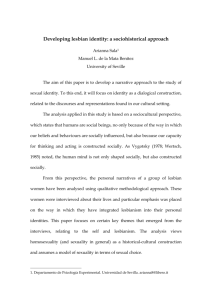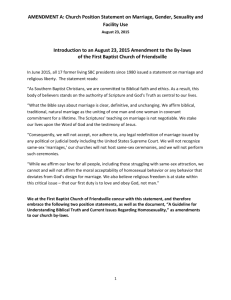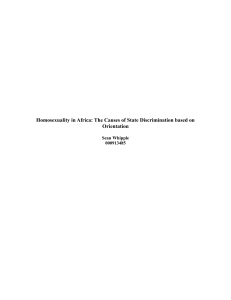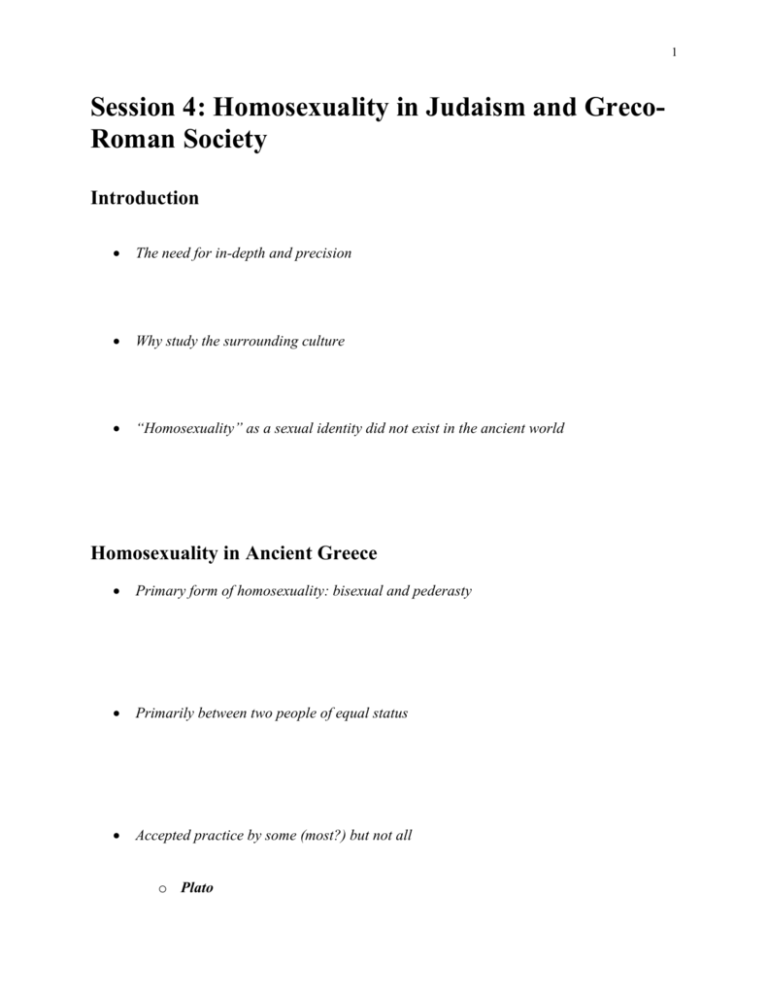
1
Session 4: Homosexuality in Judaism and GrecoRoman Society
Introduction
The need for in-depth and precision
Why study the surrounding culture
“Homosexuality” as a sexual identity did not exist in the ancient world
Homosexuality in Ancient Greece
Primary form of homosexuality: bisexual and pederasty
Primarily between two people of equal status
Accepted practice by some (most?) but not all
o Plato
2
Homosexuality in Rome
Partners of unequal status
Summary
Homosexuality in Greco-Rome
1. A spectrum of consensual and non-consensual forms of homosexuality existed
a. Non consensual
b. Consensual
i. Hadrian and Antinous
ii. Agathon was by all modern standards gay, and he had a life-long lover of
equal age and status named Pausanias (Plato, Symposium 193B; cf. Aelian,
Varia historia 2.21).1
iii. Parmenides (age 65) was in a homosexual relationship with Zenon (age
40).2
1
See ibid. 142-143.
3
iv. And the relationship between the epic Greek heroes Achilles and Patroklos
were considered by many ancient authors as homoerotic and consensual
(Plato, Symposium 179E-180B; Aeschylus, Myrmidons frags. 135-137).3
v. Consensual, same sex love—even marriages—can be found among
women around the time of Paul.
1. Iamblichos (2nd century A.D.) talks about the marriage between
two women named Berenike and Mesopotamia (Photios,
bibliotheke 94.77a-b).4
2. Lucian of Samosata mentions the marriage of Megilla and
Demonassa (Dialogues of the Courtesans, 5.1-3),5
3. Clement of Alexandria refers to women-women marriage
(Paidagogos 3.3.21.3), and Ptolemy of Alexandria (Tetrabiblos
3.14 sect. 172) refers to women taking other women as “lawful
wives.”6
2. Various beliefs about sexual orientation
a. Why this is important
i. James Brownson
ii. Brownson argues that “[w]riters in the first century, including Paul, did
not look at same sex eroticism with the understanding of sexual
orientation that is commonplace today” (p. 166), and that “the notion of
sexual orientation was absent” (p. 170), and that the “broad and generic
concepts like ‘homosexuality’ did not exist in the ancient world” (p. 218).
Brownson’s assumption provides the necessary foil to view Paul’s words
about homosexual sex in Romans 1 (cf. 1 Cor 6:9; 1 Tim 1:10) irrelevant
for our question of whether gay and lesbian unions should be sanctioned
by the church.
2
See the discussion in Hubbard, Homosexuality 6; cf. John Boswell, Christianity, Social Tolerance, and
Homosexuality: Gay People in Western Europe from the Beginning of the Christian Era to the Fourteenth Century
(Chicago: University of Chicago Press, 1980) passim.
3
Hubbard, “Peer Homosexuality” 142.
4
See Brooten, Love Between Women 51.
5
This lesbian couple, however, ends up seducing a woman named Leaena into a sexual relationship.
6
Ibid. 332.
4
b. Examples
i. Aristotle for instance said that some homoerotic desires come from habit,
but others spring from nature (Eth. 1148b). In other words, some people
are born with same sex desires.7
ii. Some ancients even speculated about certain biological defects that cause
some men to desire to receive sex from other men. [One writer explains that
males who desire to be penetrated are born with a physiological defect where semen is
abnormally secreted into the anus and sparks a desire for friction (Pseudo-Aristotelian
Problemata 4.26; cf. 879a36-880a5; 879b28-30). ]
iii. Soranus, the Greek physician from Ephesus, also believed that same-sex
eros is shaped more by nature rather than nurture, but locates the source of
the desire in the mind or spirit (De morbis chronicis 4:131, 132, 134).
iv. This seems to be shared by Philo who talks about “the disease of
effeminacy in their souls” (VCon 60; Ab 136).
v. Another writers believes that (a) both male and female contribute sperm in
conception, and (b) both male and female sperm contain a male and
female element, and (c) one male/female element will “predominate” in
the union of the two (Hippocratic De victu 1.28-29). In other words,
sexuality exists on a continuum between male and female. Men may be
born less male, and women less female. In both cases, one’s biology
contributes to their desire for sex with a particular gender.
1. We can certainly write off such speculations as unscientific,
barbaric, and downright wrong. And we should. But the veracity of
such claims about orientation are irrelevant. What matters is that
ancient writers were making such claims about orientation—
unscientific they may be. It is clear that at least some of Paul’s
contemporaries formed their own opinions about sexual
orientation; namely, that same-sex desires were biological.
7
Discussed in Martti Nissinen, Homoeroticism in the Biblical World: A Historical Perspective (Minneapolis:
Fortress, 1998) 81.
5
vi. Some writers were not as specific—or creative—as the medical texts cited
above about such orientation, yet they still seemed to believe in a form of
what we would call homosexual orientation.
vii. Pliny refers to “men who hate intercourse with women” (N.H. 28.99).8
viii. Phaedrus, who wrote his Fable around the time of Paul, presents a
mythological account about why some people desire sex with the same
gender.9 He says that the god Prometheus got drunk and attached male
genitalia to women, and women genitalia to men. In other words, some
women are trapped in men’s bodies and some men are trapped in women’s
bodies (Phdr. 4.16). The account, of course, is mythical and humorous,
but nonetheless reflects ancient assumptions that desire for same sex
intercourse is inherent.
ix. Less mythical is Lucian’s report of a woman named Megilla who says: “I
was born as a woman like the rest of you, but my mind, desire, and
everything else in me are that of a man” (Dialogue of the Courtesans 5:4).
Today, we would say that Megilla was a lesbian—or transgendered—even
if such categories were not available to the ancients.
x. Bernadette Brooten has gathered evidence from ancient astrological texts,
which suggested that sexual orientation was determined by the
arrangement of the stars.
xi. One text says: “If the Sun and Moon are in masculine signs and Venus is
also in a masculine sign in a woman’s chart, women will be born who take
on a man’s character and desire intercourse with women like men”
(Matheseos libri viii 7.25.1).10
xii. Dorotheos wrote her astrological poem, Carmen Astrologicum, right
around the time Paul was sending his letter to the Roman church. In it, she
says that if the sun and moon are at a particular location when women are
born, they “will be a Lesbian, desirous of women, and if the native is a
male, he will be desirous of males” (2.7.6).11
xiii. After looking at many more examples, Brooten concludes: “Contrary to
the view that the idea of sexual orientation did not develop until the
8
See the discussion in Wiliams, Romans Homosexuality, Kindle loc 2944.
“[W]hat cause created Tribads (lesbians) and soft men?”
10
This work (“Eight Books of the Mathesis”) by Firmicus Maternus dates to A.D. 334; see Brooten, Love Between
Women 132-137.
11
See Brooten, Love Between Women 119-120. The text has been preserved in Arabic. The word “Lesbian”
translates the Arabic sahaqa.
9
6
nineteenth century, the astrological sources demonstrate the existence
in the Roman world of the concept of a lifelong erotic orientation.”12
3. Summary:
Homosexuality in Judaism
Unanimously and Universally condemned within Judaism
o Josephus
Josephus Against Apion 2.199: “What are our marriage laws? The Law
recognizes no sexual connections, except the natural (kata physin) union
of man and wife, and that only for the procreation of children. The sexual
connection of a man with another man it abhors, and punishes any guilty
of such assault with death”
Against Apion 2.273-275 = the Gentiles found an excuse for their
“unnatural” (para physin) behavior in that their gods do the same.
o Philo
On the Contemplative Life, 59-62 = Philo condemns Plato’s symposium
and the pederasty therein. Philo likes to name the passive parter as a “manwoman.” (Nissinen, 95).
Philo condemns lesbianism for acting contrary to nature (QG 2.49; Virt.
20-21; Her. 274). (Loader essay, 3)
Philo, Laws 3:37-42 interprets Leviticus 18:22 and 20:13
straightforwardly as pederasty.
Philo interprets the Sodom story as homosexual sin (e.g. Abr. 135-136).
o Pseudo-Phocylides
Ibid. 140. Many other scholars agree with Brooten, including: Amy Richlin, “Not before Homosexuality: The
Materiality of the Cinaedus and the Roman Law against Love between Men,” Journal of the History of Sexuality 3
(1993) 523-73; Rabun Taylor, “Two Pathic Subcultures in Ancient Rome, Journal of the History of Sexuality 7
(1997) 319-371; Richard Hays, “Relations Natural and Unnatural: A Response to J. Boswell’s Exegesis of Rom. 1,”
Journal of Religious Ethics 14 (1986) 184-215.
12
7
influenced by Greek philosophy, especially Stoic thought.
written early in AD first century and designed to win Greek converts and
show many parallels between Jewish and Greek ethics.
many references to sexual morality; two references to homosexuality
Ps. Phoc. 3 = do not “arouse homosexual passion” (mete
gamoklopeein met arsena Kyprin orinein), “Cypris was the
Aphrodite of the island of Cyprus” and rousing him means
arousing an erotic passion for men (see Nissinen, 171 n. 32).
Ps. Phoc. 190-91 “Do not transgress with unlawful sex the limits
set by nature. For even animals are not pleased by intercourse of
male with male”
Ps. Phoc. 213-14 “Guard the youthful prime of life of a comely
boy, because many rage for intercourse with a man”
Ps. Phoc. 192 “And let women not imitate the sexual role of men”
(Lesbian sex).
o The Rabbis
Sifra Ahare 9:8 forbids marriage between two men and marriage between
two women (Nisinen, 101).
b. Sanhedrin 58a refers to Gen 2:24 (leave and cleave) as excluding malemale marriage along with sex with animals. (Nissinen, 99).
t. Abodah Zarah 2:1; 3:2 lists homoeroticism with bestiality.
“The rabbinic attitude toward the active partner differs form the Roman
view, according to which the behavior of the active partner was generally
not condemned…Both partners are guilty of transgressing divinely
constitute gender boundaries” (Nissinen, 99, citing Boyarin 1994, 347-48).
o Others
Letter of Aristeas 152, speaking of defiling relationships: “they not only
procure the males, they also defile mothers and daughters. We are quite
separated from these practices”
8
Conclusion


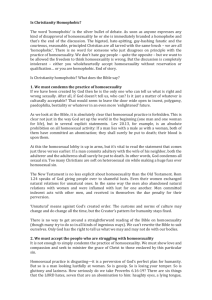
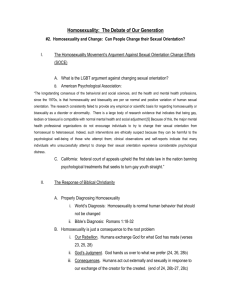
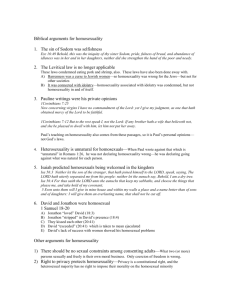

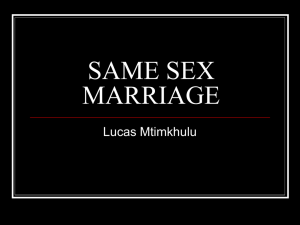
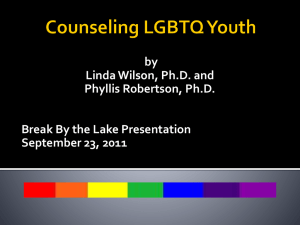
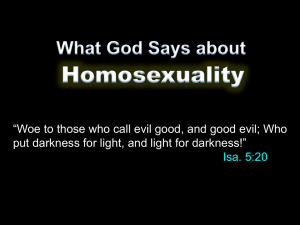
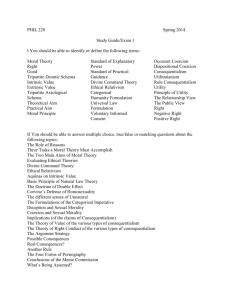

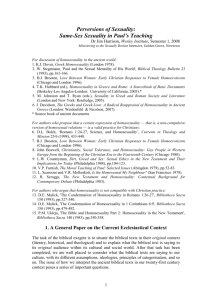
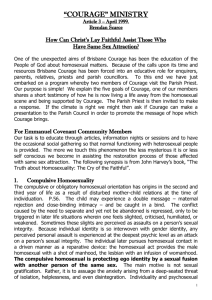
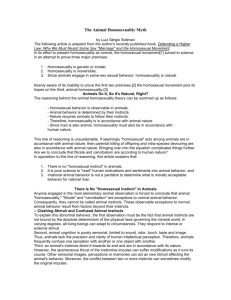
![[Appendix] List of Choi Ee-Woo`s comments against human rights](http://s3.studylib.net/store/data/007045226_1-8545e34eb3e50fd0a81b1a16eeee39bf-300x300.png)
